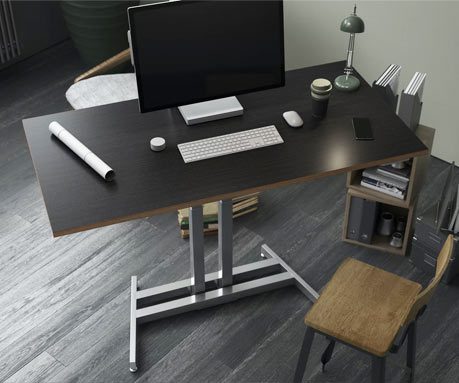Jake’s “fairly complete” explanation in just 1:42
For years we’ve been hearing about increased sedentary time in the workplace, and the health problems that go along with it. But how long should you stand at work?
Sitting vs Standing at Work
Most of the conversation around sitting and standing at work comes from desk bound workers noticing how much of their day is spent sitting. However, there is also history of research into standing workers like production line workers and bank tellers that suggests some hazards of standing to long as well.
The truth is that either one can be beneficial.
Effects of Sitting
The problem with sitting isn’t sitting per se. It’s how long we sit. How much we sit. And the way we sit.
Problems associated with sedentary time are compounded with lack of exercise, which can lead to a range of issues:
- Large muscles in legs weaken and become prone to pulls and strains.
- Flexor muscles in hips shorten, leading to hip issues.
- Varicose veins develop that can cause blood clots or discomfort.
- Lower back issues become exacerbated with poor posture and hunched positions, which can eventually damage soft tissue and discs.
An ergonomically designed office chair and attention to posture can help with these effects, but the effects of sedentary time are generally cumulative.
The Recken Desk
Now Only $799
Experience the Strong, Safe & Intelligent Recken Standing Desk
Shop The ReckenEffects of Standing
Evidence clearly points to some health risks associated with standing too long as well. Prolonged standing is defined as over 8 hours of standing per day without a lot of movement and walking around. Jobs that require standing all day are commonly associated with lower back pain, issues with leg muscles and tendons, and chronic venous insufficiency. Even standing in one position for just a couple of hours straight can cause discomfort and reduce reaction times, according to a small study published in the journal Ergonomics.
However, for jobs that traditionally involve a lot of sitting, there are a number of benefits that are associated with standing from time to time. A standing break of even a minute or two offers some clear benefits:
- allows the heart to beat faster and lungs to fill completely
- improves circulation
- allows leg muscles and joints some movement
- releases pressure on back
- gives eyes a rest from the monitor
So How Long Should You Stand at Work?
Given that everyone’s physiology is different, the exact right ratio of sitting to standing will differ from person to person. Many ergonomic experts recommend standing about 5-15 minutes out of every hour when using a standing desk, although research is ongoing. One study in the British Journal of Sports Medicine recommends that it’s ideal to move, stand, and take breaks from sitting for a total of at least 2 hours in an 8 hour work day. And working up to standing, walking, and moving for half of an 8 hour work day may increase the benefits.
Remember that standing time includes other movement during the day as well – trips to the coffee pot or the lunch table, a walk around the office or the house, a brief stretching break. All that counts as standing too. A standing desk just makes it easier to meet your overall goal.
The bigger question may be this: How often should you stand with a standing desk? Since frequent changes in position provide the most benefit, experts recommend alternating between sitting and standing every 30 minutes or so.
The Oben Desk
Now Only $599
Save $300 off our premium brushless internal drive standing desk.
Frames start at $399 – while supplies last.
Finding the Right Mix of Sitting and Standing
When creating a routine for sitting and standing, the challenge is to find just the right mix. An adjustable height standing desk is key to developing that habit. According to a review of 53 studies undertaken at the University of Pittsburgh, adjustable height standing desks are shown to do two things effectively:
- improve their ratio of standing to sitting
- increase comfort at work
In addition, there are some other ways to find the right mix for you.
Remembering to Stand
To develop the habit of standing more, some people find it useful to set a reminder on their phone. For others, a timer is unnecessary and even distracting. In that case, associating standing with certain activities like phone calls or video meetings can make it easier to incorporate. Just prioritize standing when you can.
Building up a Tolerance to Standing
Whatever your standing goal is – 30 minutes per hour, or 2 hours per day – it’s best to work up to it in the beginning. Definitely take breaks from standing if it becomes uncomfortable or distracting. Move, stretch, and refocus your eyes. You may find that you can stand longer if you keep your weight on the balls of your feet, with knees slightly bent to relieve hips and knees.
Features That Make Standing Easier
The most important tool to help you stand more at work is the desk itself – a height adjustable desk. The faster and easier the adjustment, the more likely you’ll continue to incorporate it into your routine. There are a variety of desks that offer powered lifting assistance to make sitting and standing second nature.
On top of that, adding an anti fatigue mat can help make standing time more comfortable. These mats are designed to give extra cushion to stand comfortably, which keeps feet from getting tired and increases standing time. Some mats are also contoured to encourage small movements that both improve blood flow and help with leg discomfort or lower back pain.
How long should you stand at work? As long as you comfortably can. And a standing desk makes it easier to find the right mix for your work day.









